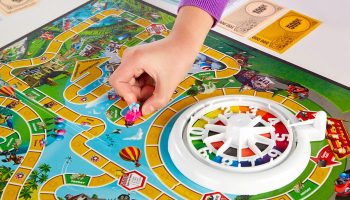Game designer Dirk Barsuhn on what inspired his new tile-laying game, Ananda

Dirk, it’s great to catch up. Before we dive into Ananda, I understand you worked in banking for years before embracing game design…
Yes, I quit my job four years ago to take over the care of my mother at home. This gave me more time to work on my prototypes again. Ananda was one of those games that I’d had in my head for a long time and was now finally able to tackle.
For anyone new to the game, how would you pitch it?
Ananda is a classic tile-laying game in the tradition of dominoes and mahjong, in which the players build a three-dimensional temple together. Players try to build as many tiles of one colour as possible in their turn in order to be allowed to discard the corresponding cards of the same colour. Whoever has collected the most karma points in their discard pile at the end wins the game.

Where did the idea for this come from?
The idea for Ananda came to me when I saw mahjong for the first time. However, I didn’t know that the tiles in mahjong are built up first and then built up again later. When I wanted to play mahjong one day, I was initially disappointed by the complicated structure of the game… I thought you would build up the tiles as you went along instead of dismantling them. That was too cumbersome for me – I instead looked for a game where you could build up the tiles bit by bit to end up with a beautiful temple on the board. When I couldn’t find a comparable game, the idea for Ananda was born.
Amazing! And the theme took shape then too?
Yes, I ordered white dominoes and covered them with colorful mandala symbols. Then I looked for a way to build the dominoes on top of each other to create a beautiful temple at the end of the game. Inspired by Far Eastern aesthetics and mandala symbols, the theme was clear from the start. It’s about the balance between temple building and meditation.

Ananda is published by Zoch. What made them a great partner for the game?
Zoch is known for high-quality games with exceptional game material – that’s why I thought Zoch was the ideal publisher for Ananda. And when I presented the game to Zoch’s Walter Scholz for the first time, we quickly agreed on the high-quality design and the unique material, which makes the game an extraordinary experience.
At the beginning, I had other game components in mind… But together with Anton Knittel, who edited the game, we managed to turn the prototype into a very catchy puzzle game with tactical card elements. Many thanks to the team for the wonderful collaboration and the successful end result.
Absolutely, it looks lovely. Looking ahead, what other titles should we keep an eye out for from you?
Last year, Piatnik published my first game, Tea Time Crime, which I am also very proud of.
I’m sold on the name alone!
Ha! It’s a dice puzzle game in which detectives protect an English aristocratic house in search of burglars. And in spring 2025, another game of mine will be published by Piatnik, which I’m already really looking forward to.

We’ll have to have a chat about that when it debuts! Last question Dirk, what helps you have ideas for games?
Playing, playing, playing! And observing the world through the eyes of a child. That’s one of the keys for me to open new worlds.
I always try to forget everything I know about game development at the start of a new idea. I want to give freedom and creativity as much space as possible, without thinking about whether the new idea can even be implemented in terms of game technology. And sometimes it works and the end result is games as beautiful as Ananada!
Sounds like a winning approach. Thanks again Dirk, and congrats on Ananda.
–
To stay in the loop with the latest news, interviews and features from the world of toy and game design, sign up to our weekly newsletter here



























